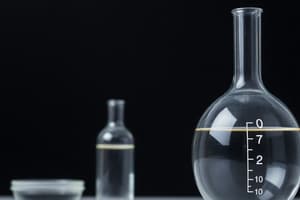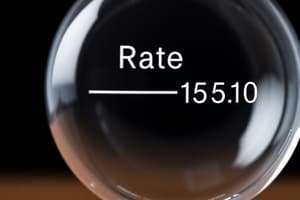Podcast
Questions and Answers
What shape does the kinetic plot for a second-order reaction take when plotting 1/[A] versus time?
What shape does the kinetic plot for a second-order reaction take when plotting 1/[A] versus time?
- A straight line (correct)
- An exponential curve
- A curved line
- A hyperbolic curve
What is the assumption made about stoichiometric coefficients for simplification in second-order reactions?
What is the assumption made about stoichiometric coefficients for simplification in second-order reactions?
- They are different for each reactant
- They are equal to the reaction rate
- They are unity (correct)
- They are all zero
What happens to the order of a reaction if simultaneous multiple body collisions are considered?
What happens to the order of a reaction if simultaneous multiple body collisions are considered?
- The reaction order increases proportionally
- The reaction order remains the same
- The reaction order can exceed 2 (correct)
- The reaction order decreases
In the equation 1/(a0 - b0) ln((b0 (a0 - x)) / (a0 (b0 - x))) = kAt, what does the slope represent?
In the equation 1/(a0 - b0) ln((b0 (a0 - x)) / (a0 (b0 - x))) = kAt, what does the slope represent?
What is the significance of defining x as the moles of A that have reacted?
What is the significance of defining x as the moles of A that have reacted?
Flashcards are hidden until you start studying
Study Notes
First-Order Reactions
- A first-order reaction rate is dependent on the concentration of a single reactant (A).
- The rate of change in the concentration of Z (dx/dt) is equal to kA (a0 - x), where kA is the first-order rate constant.
- Integration of the rate equation yields -ln(a0 - x) = kAt - I, where I is the constant of integration.
- The rate constant (kA) has units of s^-1.
- A plot of ln[A] versus t is linear with a slope of -kA.
Second-Order Reactions
- A second-order reaction rate is dependent on the product of the concentrations of two reactants (A and B).
- The rate equation is r = kA (a0 - x)(b0 - x), where a0 and b0 are the initial concentrations of A and B.
- Integration of the rate equation yields ln[b0(a0 - x)/a0(b0 - x)] = kAt.
- A plot of 1/[A] versus time yields a straight line for a second-order reaction.
Zero-Order Reactions
- A zero-order reaction rate is independent of the concentration of reactants.
- The rate equation is r = kA, where kA is the zero-order rate constant.
- Integration of the rate equation yields x = kAt.
- A plot of the product concentration versus time yields a straight line with a slope equal to the apparent zero-order rate constant.
nth-Order Reactions
- Higher-order reactions are uncommon due to the low probability of simultaneous multiple body collisions.
- Many rate laws incorporate multiple elementary reactions, resulting in a composite rate law with order >2.
Studying That Suits You
Use AI to generate personalized quizzes and flashcards to suit your learning preferences.




